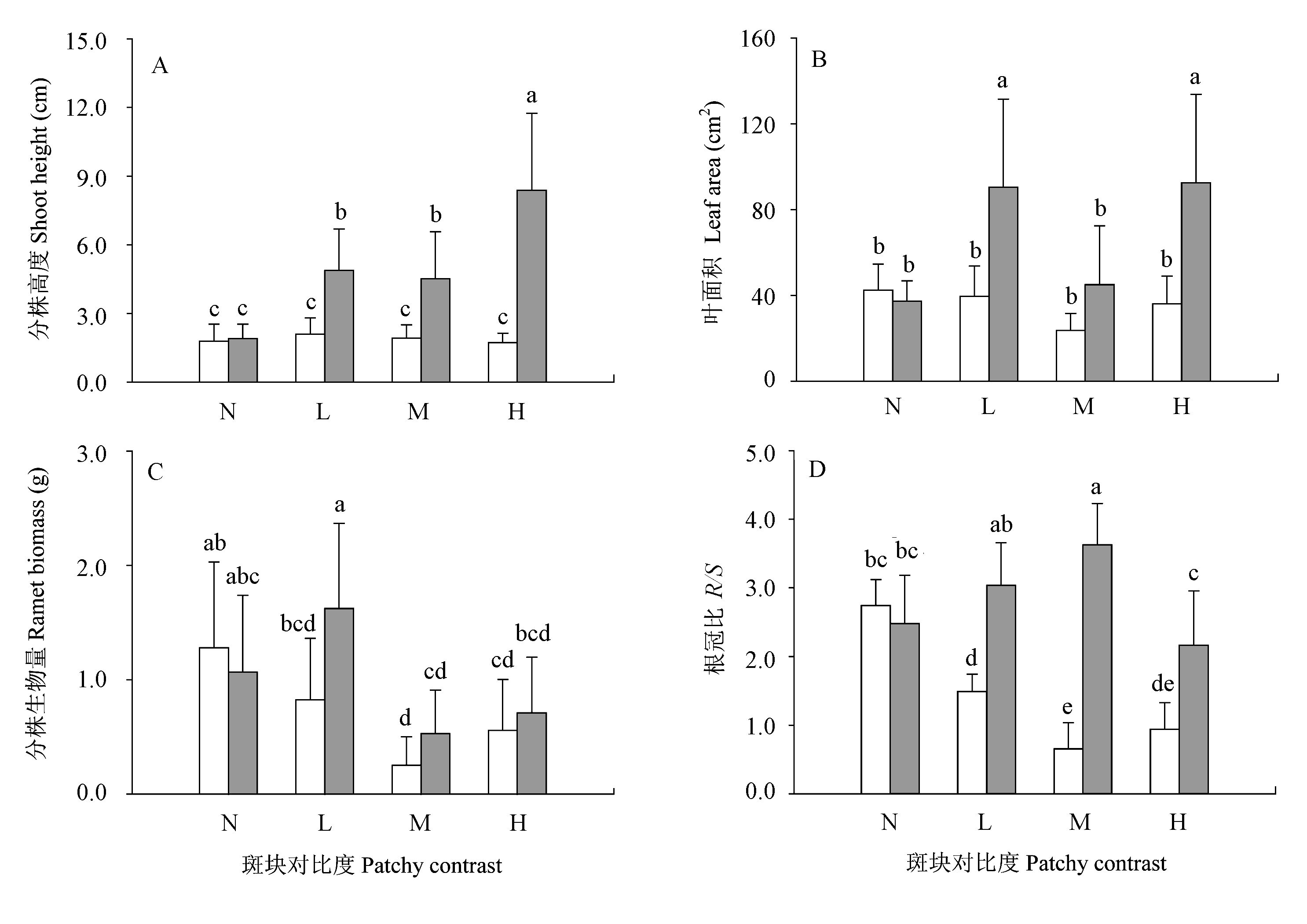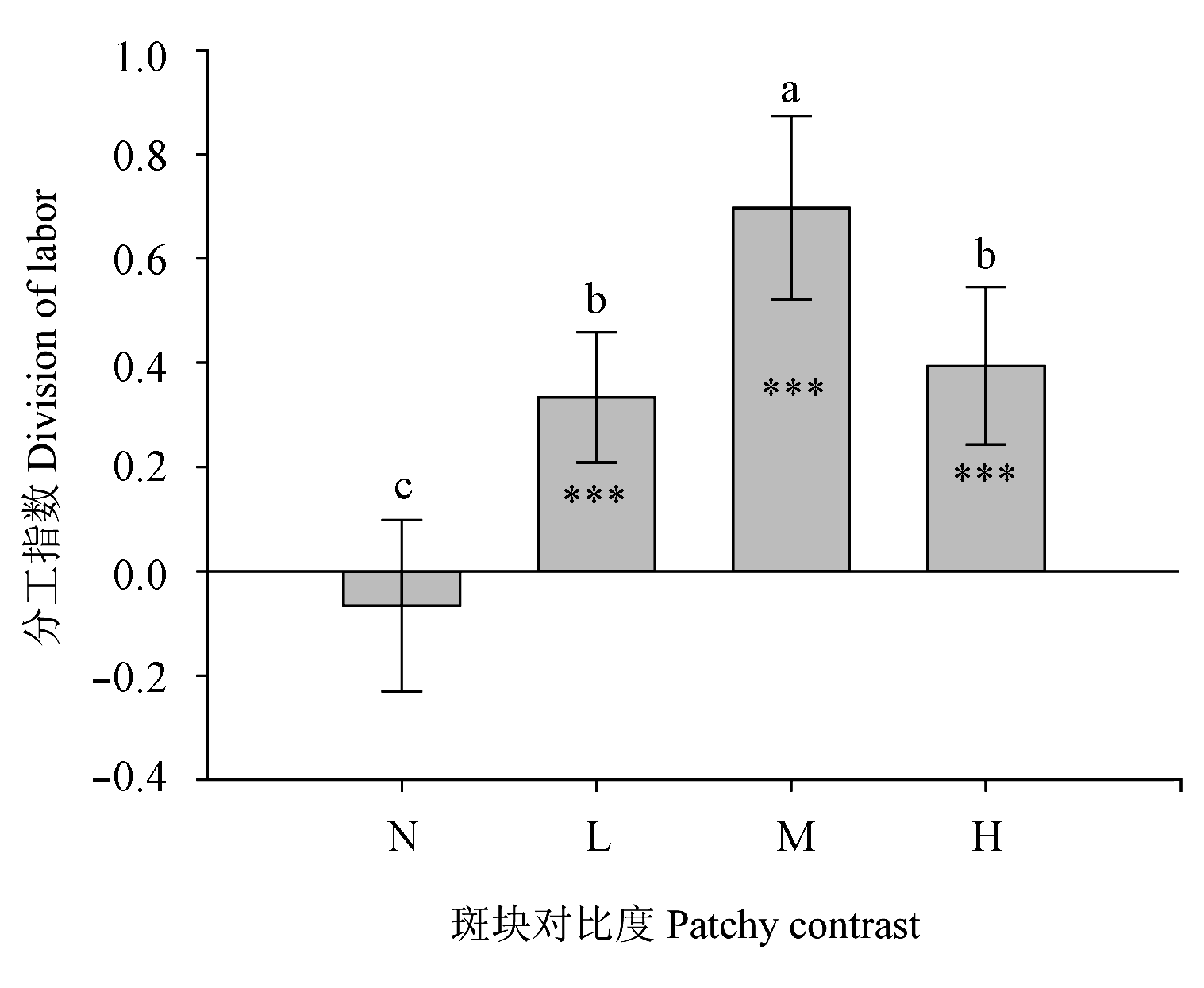

植物生态学报 ›› 2008, Vol. 32 ›› Issue (5): 1166-1174.DOI: 10.3773/j.issn.1005-264x.2008.05.021
收稿日期:2008-01-25
接受日期:2008-04-25
出版日期:2008-01-25
发布日期:2008-09-30
通讯作者:
王正文
作者简介:*(wangzw@ibcas.ac.cn)基金资助:
LI Yuan-Heng1,2, WANG Zheng-Wen2,*( ), MA Hui-Ling1
), MA Hui-Ling1
Received:2008-01-25
Accepted:2008-04-25
Online:2008-01-25
Published:2008-09-30
Contact:
WANG Zheng-Wen
摘要:
相互连接的克隆植物分株分别处于资源互补性的不同斑块时, 将可能发生形态结构的特化, 以更有效地吸收利用所处斑块中丰富的资源, 形成分株的功能分化, 即克隆内分工。生境的斑块对比度, 作为资源或环境异质性的主要素, 在一定程度上决定克隆内分工的发生状况。该文以鹅绒委陵菜(Potentilla anserina)为材料, 在自然条件下将多组分株对置于不同的斑块对比度处理下, 比较了它们克隆内分工的发生状态, 试图发现分工与斑块对比度的关系, 同时考察在克隆分工过程中分株的可塑性变化及其与分工的关系。该实验的理论假设是: 分株发生分工的程度与分株所处斑块的资源对比度成正相关。研究结果表明, 鹅绒委陵菜分株的高度和叶面积对局部光照环境产生强烈的可塑性反应, 反应的结果是增加了对匮乏的光资源的获取。从分株根冠比和我们提出的分工指数来看, 分工的程度在一定的斑块对比度范围内随斑块对比度的增强而增强, 但到达一个最大值后又迅速降低。鹅绒委陵菜分株之间的分工和结构特化往往滞后于分株对所处局部环境的适应性可塑性变化, 而后者往往在分株之间具有独立性和局部特征。克隆内分工主要依赖于生物量分配的调节而实现, 其发生状态都是分株系统在分工收益、分工代价与分工风险之间权衡的结果, 而这种结果在很大程度上取决于分株所处的斑块对比度。
李元恒, 王正文, 马晖玲. 生境斑块对比度对鹅绒委陵菜克隆内分工的影响. 植物生态学报, 2008, 32(5): 1166-1174. DOI: 10.3773/j.issn.1005-264x.2008.05.021
LI Yuan-Heng, WANG Zheng-Wen, MA Hui-Ling. PATCHY CONTRAST OF HABITAT AFFECTS INTRACLONAL DIVISION OF LABOR OF POTENTILLA ANSERINA. Chinese Journal of Plant Ecology, 2008, 32(5): 1166-1174. DOI: 10.3773/j.issn.1005-264x.2008.05.021
| 作用因素 Factors | 地上部高度 Shoot height | 分株叶面积 Leaf area | 分株生物量Ramet biomass | 根冠比 R/S ratio | |||||||
| F | p | F | p | F | p | F | p | ||||
| 斑块对比度 PC1) | 9.31 | <0.000 1 | 5.98 | 0.001 5 | 7.50 | 0.000 3 | 9.10 | <0.000 1 | |||
| 分株位置 Position2) | 49.74 | <0.000 1 | 22.24 | <0.000 1 | 2.90 | 0.095 1 | 84.64 | <0.000 1 | |||
| 交互作用 PC × position 3) | 9.88 | <0.000 1 | 4.74 | 0.005 7 | 1.96 | 0.133 2 | 19.16 | <0.000 1 | |||
| 1): df=3 2): df =1 3): df =3 p<0.05的p值以黑体显示 Values of p<0.05 are in bold | |||||||||||
表1 斑块对比度、分株位置及交互作用对分株地上部高度、叶面积、生物量和根冠比影响的双因素方差分析结果
Table 1 Two-way ANOVA for the effects of patchy contrast (PC), position and their interaction on shoot height, leaf area, ramet biomass and R/S ratio
| 作用因素 Factors | 地上部高度 Shoot height | 分株叶面积 Leaf area | 分株生物量Ramet biomass | 根冠比 R/S ratio | |||||||
| F | p | F | p | F | p | F | p | ||||
| 斑块对比度 PC1) | 9.31 | <0.000 1 | 5.98 | 0.001 5 | 7.50 | 0.000 3 | 9.10 | <0.000 1 | |||
| 分株位置 Position2) | 49.74 | <0.000 1 | 22.24 | <0.000 1 | 2.90 | 0.095 1 | 84.64 | <0.000 1 | |||
| 交互作用 PC × position 3) | 9.88 | <0.000 1 | 4.74 | 0.005 7 | 1.96 | 0.133 2 | 19.16 | <0.000 1 | |||
| 1): df=3 2): df =1 3): df =3 p<0.05的p值以黑体显示 Values of p<0.05 are in bold | |||||||||||

图2 处于不同斑块对比度及不同位置分株的高度(A)、叶面积(B)、分株生物量(C)和根冠比(D) 白色柱代表Ro分株, 灰色柱代表Ri分株。误差线指示标准误。标记有相同字母的两处理间在p=0.05水平上差异不显著。实验处理N、L、M、H、Ro和Ri释义参见图1 Open bars are for Ro, and closed bars are for Ri. Error bars = ± SE. The treatments with the same letter are not significantly different at p=0.05. See Fig.1 for the definitions of experimental treatments N, L, M, H, Roand Ri
Fig. 2 Shoot height (A), leaf area (B), ramet biomass (C), R/S (D) of ramets differently positioned under four different patchy contrasts

图3 不同斑块对比度条件下鹅绒委陵菜克隆 内分工的比较 误差线指示标准误。标记有相同字母的两处理间在p=0.05水平上差异不显著。星号表示所在处理的劳动分工指数与0的差异显著性学生t检验结果。***: p<0.001。实验处理N、L、M和H释义参见图1 Error bars = ±SE. The treatments with the same letter are not significantly different at p=0.05. The asterisks on the bars denoted the student t-test results for the comparison between the indices of division of labor for due treatment and 0. ***: p<0.001. SeeFig.1 for the definitions of experimental treatments N, L, M and H
Fig. 3 Comparison of intraclonal division of labor of Potentilla anserina between different patchy contrasts
| [1] | Alpert P (1991). Nitrogen sharing among ramets increases clonal growth in Fragaria chiloensis. Ecology, 72,69-80. |
| [2] | Alpert P (1996). Nutrient sharing in natural clonal fragments of Fragaria chiloensis. Journal of Ecology, 84,395-406. |
| [3] |
Alpert P (1999a). Clonal integration in Fragaria chiloensis differs between populations: ramets from grassland are selfish. Oecologia, 120,69-76.
DOI URL PMID |
| [4] | Alpert P (1999b). Effects of clonal integration on plant plasticity in Fragaria chiloensis. Plant Ecology, 141,99-106. |
| [5] |
Alpert P, Mooney HA (1986). Resource sharing among ramets in the clonal herb. Fragaria chiloensis. Oecologia, 70,227-233.
DOI URL PMID |
| [6] | Alpert P, Stuefer JF (1997). Division of labour in clonal plants. In: de Kroon H, van Groenendael J eds. The Ecology and Evolution of Clonal Plants. Backhuys Publishers, Leiden, The Netherlands, 137-154. |
| [7] | Caraco T, Kelly CK (1991). On the adaptive value of physiological integration in clonal plants. Ecology, 72,81-93. |
| [8] |
Caruso CM, Maherali H, Sherrard M (2006). Plasticity of physiology in Lobelia: testing for adaption and constraint. Evolution, 60,980-990.
URL PMID |
| [9] | D’Hertefeldt T, Falkengren-Grerup U (2002). Extensive physiological integration in Carex arenaria and Carex disticha in relation to potassium and water availability. New Phytologist, 156,469-477. |
| [10] | de Kroon H, Huber H, Stuefer JF, van Groenendael JM (2005). A modular concept of phenotypic plasticity in plants. New Phytologist, 166,73-82. |
| [11] |
DeWitt TJ, Sih A, Wilson DS (1998). Costs and limits of phenotypic plasticity. Trends in Ecology and Evolution, 13,77-81.
URL PMID |
| [12] | Dong M (1993). Morphological plasticity of the clonal herb Lamiastrum galeobdolon (L.) Ehrend. & Polatschek in response to partial shading. New Phytologist, 124,291-300. |
| [13] |
Dong M (1995). Morphological responses to local light conditions in clonal herbs from contrasting habitats, and their modification due to physiological integration. Oecologia, 101,282-288.
DOI URL PMID |
| [14] | Dong M (董鸣) (1996). Clonal growth in plants in relation to resource heterogeneity: foraging behavior. Acta Botanica Sinica (植物学报), 38,828-835. (in Chinese with English abstract) |
| [15] |
Dorn LA, Pyle EH, Schmitt J (2000). Plasticity to light cues and resources in Arabidopsis thaliana: testing for adaptive value and costs. Evolution, 54,1982-1994.
URL PMID |
| [16] | Eriksson O, Jerling L (1990). Hierarchical selection and risk spreading in clonal plants. In: van Groenendael J, de Kroon H eds. Clonal Growth in Plants: Regulation and Function. SPB Academic Publishing, The Hague, 79-94. |
| [17] |
Friedman D, Alpert P (1991). Reciprocal transport between ramets increases growth of Fragaria chiloensis when light and nitrogen occur in separate patches but only if patches are rich. Oecologia, 86,76-80.
DOI URL PMID |
| [18] | Gillespie J (1974). Polymorphism in patchy environments. American Naturalist, 108,145-151. |
| [19] |
Hutchings MJ, John EA (2004). The effects of environmental heterogeneity on root growth and root/shoot partitioning. Annals of Botany, 94,1-8.
DOI URL PMID |
| [120] | Kotliar NB, Wiens JA (1990). Multiple scales of patchiness and patch structure: a hierarchical framework for the study of heterogeneity. Oikos, 59,253-260. |
| [21] | Marshall C (1990). Source-sink relations of interconnected ramets. In: van Groenendael J, de Kroon H eds. Clonal Growth in Plants: Regulation and Function. SPB Academic Publishing, The Hague, 23-41. |
| [22] | Niva M, Svensson BM, Karlsson PS (2006). Effects of light and water availability on shoot dynamics of the stoloniferous plant Linnaea borealis. Écoscience, 13,318-323. |
| [23] | Pitelka LE, Ashmun JW (1985). Physiology and integration of ramets in clonal plants. In: Jackson JBC, Buss LW, Cook RE eds. Population Biology and Evolution of Clonal Organisms. Yale University Press, New Haven, CT, USA, 399-435. |
| [24] |
Robin C, Hay MJM, Newton PCD (1994). Effect of light quality (red : far-red ratio) and defoliation treatments applied at a single phytomer on axillary bud out growth in Trifolium repens L.. Oecologia, 100,236-242.
DOI URL PMID |
| [25] | Roiloa SR, Alpert P, Tharayil N, Hancock G, Bhowmik PC (2007). Greater capacity for division of labour in clones of Fragaria chiloensis from patchier habitats. Journal of Ecology, 95,397-405. |
| [26] | SAS Institute Inc. (2004). SAS 9.1.2 Qualification Tools User’s Guide. SAS Institute Inc., Cary,NC,USA. |
| [27] | Stuefer JF (1996). Potential and limitations of current concepts regarding the response of clonal plants to environmental heterogeneity. Vegetatio, 127,55-70. |
| [28] | Stuefer JF (1998). Two types of division of labour in clonal plants: benefits, costs and constraints. Perspectives in Plant Ecology, Evolution and Systematics, 1,47-60. |
| [29] | Stuefer JF, During HJ, Schieving F (1998). A model on optimal root-shoot allocation and water transport in clonal plants. Ecological Modelling, 111,171-186. |
| [30] |
Stuefer JF, Hutchings MJ (1994). Environmental heterogeneity and clonal growth: a study of the capacity for reciprocal translocation in Glechoma hederacea L.. Oecologia, 100,302-308.
URL PMID |
| [31] | Suzuki JI, Stuefer JF (1999). On the ecological and evolutionary significance of storage in clonal plants. Plant Species Biology, 14,11-17. |
| [32] | Thompson L (1995). Sites of photoperception in white clover. Grass and Forage Science, 50,259-262. |
| [33] | Wang ZW, Li LH, Han XG, Dong M (2004). Do rhizome severing and shoot defoliation affect clonal growth of Leymus chinensis at ramet population level. Acta Oecologica, 26,255-260. |
| [34] | Yu FH, Chen YF, Dong M (2002a). Clonal integration enhances survival and performance of Potentilla anserina, suffering from partial sand burial on Ordos plateau, China. Evolutionary Ecology, 15,303-318. |
| [35] | Yu FH, Dong M, Krüsi B (2004). Clonal integration helps Psammochloa villosa survive sand burial in an inland dune. New Phytologist, 162,697-704. |
| [36] | Yu FH, Dong M, Zhang CY (2002b). Intraclonal resource sharing and functional specialization of ramets in response to resource heterogeneity in three stoloniferous herbs. Acta Botanica Sinica (植物学报), 44,468-473. |
| [37] | Zhou HK (周华坤), Zhou XM (周兴民), Zhou L (周立), Shen ZX (沈振西), Li YN (李英年) (2002). The clonal growing characteristic in the stoloniferous herb. Potentilla anserina. Acta Botanica Boreali- Occidentalia Sinica (西北植物学报), 22,9-17. (in Chinese with English abstract) |
| [1] | 高敏, 缑倩倩, 王国华, 郭文婷, 张宇, 张妍. 低温胁迫对不同母树年龄柠条锦鸡儿种子萌发幼苗生理和生长的影响[J]. 植物生态学报, 2024, 48(2): 201-214. |
| [2] | 李斐, 孙明伟, 钟尚志, 宋文政, 钟晓月, 孙伟. 不同光合类型牧草对干旱-复水的光合生理响应及生长适应策略[J]. 植物生态学报, 2022, 46(1): 74-87. |
| [3] | 邹显花, 胡亚楠, 韦丹, 陈思同, 吴鹏飞, 马祥庆. 磷高效利用杉木对低磷胁迫的适应性与内源激素的相关性[J]. 植物生态学报, 2019, 43(2): 139-151. |
| [4] | 孟令君, 姚杰, 秦江环, 范春雨, 张春雨, 赵秀海. 吉林蛟河针阔混交林乔木幼苗组成及其密度格局影响因素[J]. 植物生态学报, 2018, 42(6): 653-662. |
| [5] | 严月, 朱建军, 张彬, 张艳杰, 鲁顺保, 潘庆民. 草原生态系统植物地下生物量分配及对全球变化的响应[J]. 植物生态学报, 2017, 41(5): 585-596. |
| [6] | 罗永开, 方精云, 胡会峰. 山西芦芽山14种常见灌木生物量模型及生物量分配[J]. 植物生态学报, 2017, 41(1): 115-125. |
| [7] | 王杨, 徐文婷, 熊高明, 李家湘, 赵常明, 卢志军, 李跃林, 谢宗强. 檵木生物量分配特征[J]. 植物生态学报, 2017, 41(1): 105-114. |
| [8] | 张蔷, 李家湘, 徐文婷, 熊高明, 谢宗强. 中国亚热带山地杜鹃灌丛生物量分配及其碳密度估算[J]. 植物生态学报, 2017, 41(1): 43-52. |
| [9] | 刘帅, 廖嘉星, 肖翠, 范秀华. 长白山次生针阔混交林乔木幼苗存活的影响因素分析[J]. 植物生态学报, 2016, 40(7): 711-722. |
| [10] | 陈智裕, 李琦, 邹显花, 马祥庆, 吴鹏飞. 邻株竞争对低磷环境杉木幼苗光合特性及生物量分配的影响[J]. 植物生态学报, 2016, 40(2): 177-. |
| [11] | 陈云, 王婷, 李培坤, 姚成亮, 袁志良, 叶永忠. 河南木札岭温带落叶阔叶林群落特征及主要乔木空间分布格局[J]. 植物生态学报, 2016, 40(11): 1179-1188. |
| [12] | 彭一可, 罗芳丽, 李红丽, 于飞海. 根状茎型植物扁秆荆三棱对土壤养分异质性尺度和对比度的生长响应[J]. 植物生态学报, 2013, 37(4): 335-343. |
| [13] | 王敏, 苏永中, 杨荣, 杨晓. 黑河中游荒漠草地地上和地下生物量的分配格局[J]. 植物生态学报, 2013, 37(3): 209-219. |
| [14] | 郭柯, 刘长成, 董鸣. 我国西南喀斯特植物生态适应性与石漠化治理[J]. 植物生态学报, 2011, 35(10): 991-999. |
| [15] | 周双喜, 吴冬秀, 张琳, 施慧秋. 降雨格局变化对内蒙古典型草原优势种大针茅幼苗的影响[J]. 植物生态学报, 2010, 34(10): 1155-1164. |
| 阅读次数 | ||||||
|
全文 |
|
|||||
|
摘要 |
|
|||||
Copyright © 2022 版权所有 《植物生态学报》编辑部
地址: 北京香山南辛村20号, 邮编: 100093
Tel.: 010-62836134, 62836138; Fax: 010-82599431; E-mail: apes@ibcas.ac.cn, cjpe@ibcas.ac.cn
备案号: 京ICP备16067583号-19